How to Increase Revenue by Targeting Impulse Buyers
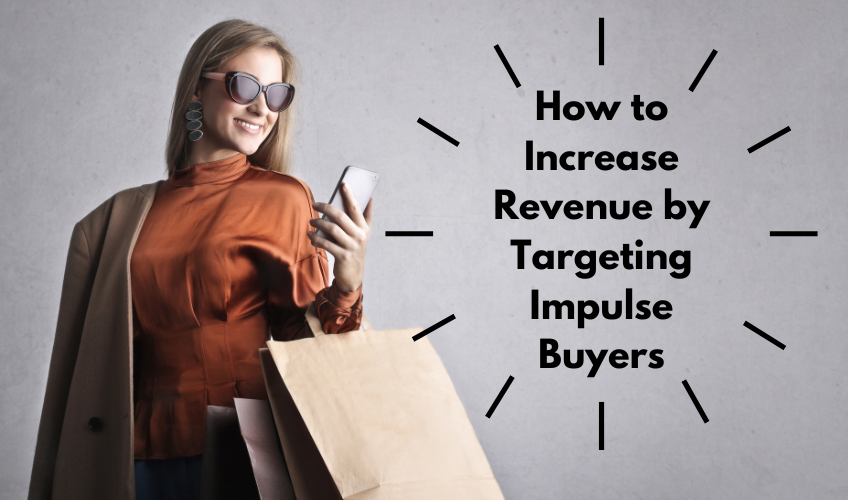
Every consumer is different.
Some people like to shop online, and others prefer shopping in stores.
Some customers spend days or weeks researching a product before purchasing, while others buy something without any prior intention.
This is called an impulse purchase.
Believe it or not, more people are guilty of this than you would think.
Have you ever bought something impulsively?
We’re willing to bet you have.
In fact, 36% of Americans admit they made an impulse buy.
How much are they spending?
If someone buys a magazine or a candy bar while standing in line at a grocery store, that counts as an impulse purchase.
But that’s really nothing to get excited over.
Consider this, however: 54% of consumers have spent more than $100 on an impulse purchase, and 20% have spent over $1,000.
Those are the numbers that can motivate marketers and retailers.
As an example, let’s take a look at something that everyone buys.
Clothes.
Here’s some data comparing planned and impulse clothing purchases grouped by age and household income of shoppers:
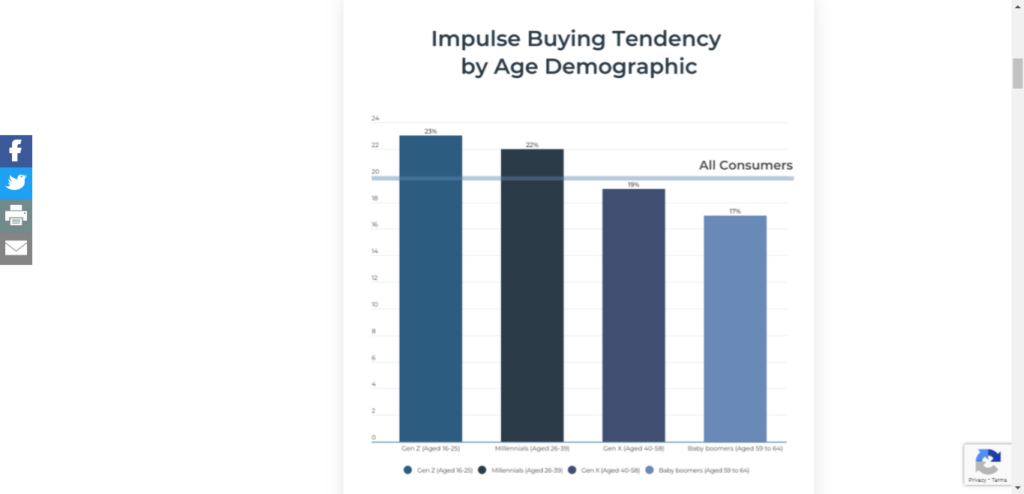
It appears nobody is immune to this.
You might think that Gen Z is more likely they will spend it impulsively.
But based on this data, that is not the case.
There’s only a 6% difference between Gen Z and the Boomers for impulsive spending habits.
Whether you have a brick-and-mortar store location or an ecommerce website, you can increase your revenue if you learn how to target impulse shoppers.
As you can see from the numbers above, impulse buyers aren’t hard to find.
However, you need to position your brand, products, and marketing campaigns accordingly to encourage these people to spend more money.
We’ll show you how.
Understand the psychological characteristics of impulsive consumers
Younger generations are more likely to make impulsive purchases.
But why?
It has to do with psychology and personality traits.
According to marketing experts Bryan and Jeffrey Eisenberg, consumers can be divided into four personality categories:

Impulse buyers fall into the spontaneous category on this graphic.
They are more emotional as opposed to methodical thinkers.
Impulsive shoppers are willing to take risks and respond to visual cues like color schemes.
Studies suggest that impulse buying translates to gratification.
Those seeking self-gratification and approval from others are likelier to have impulsive tendencies.
The risks associated with an impulse purchase can suggest the buyer may not consider the consequences of their spending.
Given their income and other expenses, they may not realize the item puts them over budget.
While some people are more susceptible to impulse purchases than others, the data we showed you earlier indicates that most consumers have made impulse buys.
This means these traits are within all of us.
As a marketer, you need to find ways to exploit those tendencies.
If you do this correctly, you could turn just about anyone into an impulsive customer.
Focus on the right products
First, you should figure out what products you want to entice people to buy.
Ideally, these products will have a high-profit margin for your company.
Depending on your business, you might sell hundreds or even thousands of items.
Which ones are the right products to emphasize?
Take a look at how men and women shop impulsively:
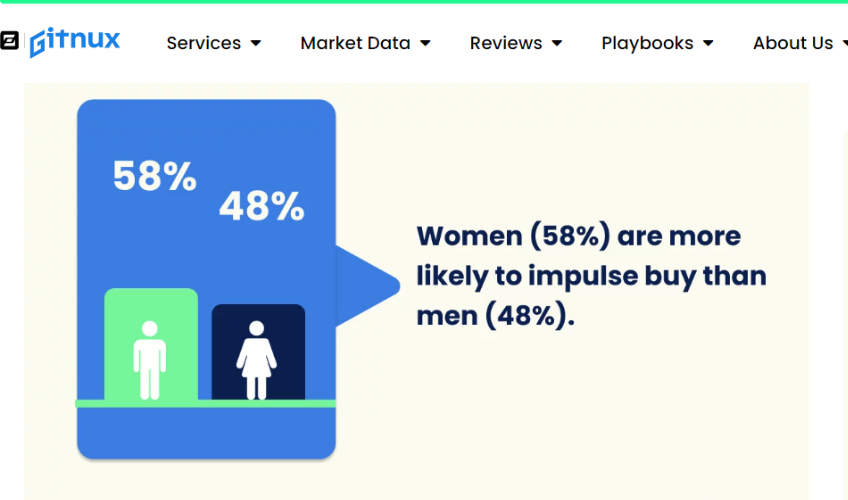
Decide whom you’re targeting.
If you’re targeting impulsive men, you want to focus on products they could buy for their spouses.
But if you’re targeting women, you should concentrate on items suitable for children.
You’ll want to place these items in your store or your website strategically, but we’ll discuss that later.
Not every product you sell should be marketed as an impulse buy.
Some items are necessities. People will buy those regardless.
For example, let’s say you own a home furnishings store.
Your primary target market is new homeowners.
You know they’ll need certain items for their houses.
Things such as a bed, couch, and kitchen table are needed in a home.
But an impulsive buy could be an ottoman for their living room or an extra television for the bedroom.
Those aren’t necessities, but consumers may be swayed to buy them even if they had no intention of doing so in the first place.
Look at this bedroom set from Bed Bath & Beyond:
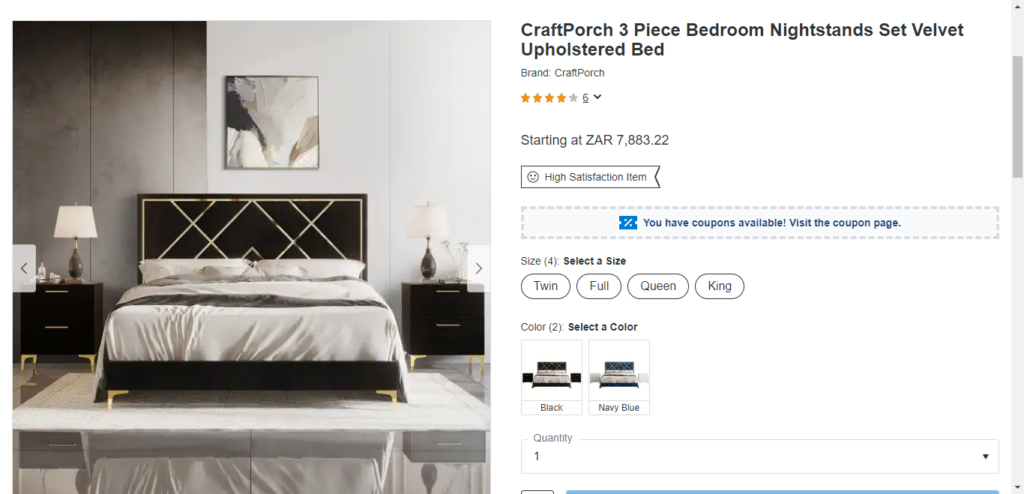
Items such as the painting, extra lights, throw pillows, rug, and artificial flowers would be good products for impulsive buyers.
Consumers may visit a store looking to buy bed sheets, which is a necessity, and leave with artificial flowers and a painting, which are luxury and decorative pieces.
Create FOMO (fear of missing out)
Promotional campaigns are a great way to target impulsive shoppers.
Discounts, deals, and coupons available only for a limited time might do the trick.
The concept of FOMO makes the consumer think, “If I don’t act now, I’ll lose out on this opportunity.”
Now that you’ve narrowed down the products you want to focus on, it’s time to figure out how to advertise them.
Create a sense of urgency by saying there is a limited quantity remaining.
Take a look at this promotional email from GetResponse:

They use certain keywords to create FOMO, which can appeal to an impulsive shopper:
- Only 500 accounts remaining
- Don’t miss out
- 40% off
- Summer sale
Come up with ways to incorporate this strategy into your business.
For example, let’s say you have an online store.
A consumer may be at the mall for something else, not intending to check out your store.
You have to draw them in when they are scrolling by.
Take a look at this Banana Republic online exclusive sale:

It doesn’t just say 40% off.
The sign says online exclusive and today only to entice impulse shoppers to click.
Even if they had no intention of buying clothes, a shopper might think 40% off is too good to pass up.
That’s the idea behind creating urgency and FOMO.
Learn how to place items strategically
Placement is key for both brick-and-mortar stores as well as ecommerce sites.
Even though our society is moving toward digital shopping, most impulse purchases still occur in physical store locations.
In fact, 68% of impulse buys occur in-store instead of online.

But that doesn’t mean ecommerce stores should avoid targeting impulse buyers.
Research suggests impulsive online sales jumped 60% over a period of time when total online sales increased by 12.6%.
Those numbers are extremely encouraging for online retailers.
Now that you’ve identified which products are the best to focus on to trigger impulsive behavior in your prospective customers, you must ensure they are placed properly.
On an ecommerce site, you should put these items on your homepage.
Don’t make shoppers go searching for something.
That defeats the purpose.
You want someone to stumble upon your website, see something attractive, and buy it.
Check out the SAXX website:
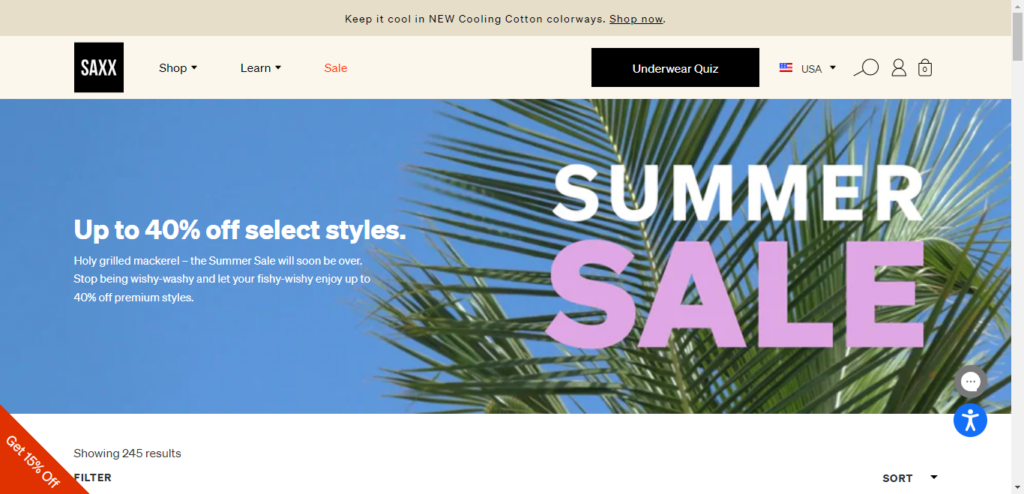
The items are clearly displayed on their homepage.
In addition to offering these products at a discounted rate, SAXX used FOMO to entice impulse buyers as well.
When people visit their website, they may purchase something they don’t really need and never intend to buy.
Those of you with a retail store location need to apply the same idea to your layout.
Impulsive items shouldn’t be hidden in the aisles.
Present these at the end of a row, on a separate table, or display areas.
Put items near the register so customers see them on their way out or while waiting in line.
Remember what we said earlier about the differences between male and female shoppers?
Based on that information, you could display some women’s products near the men’s section of your store to entice men to buy for their wives.
You could position some children’s items near the women’s section to encourage women to buy for their kids.
Simplify the buying process
Once someone decides to make an impulse purchase, you don’t want to give them any chance to change their mind.
The buying process needs to be as fast and easy as possible.
For example, let’s say you have only display models of a certain product in your store.
For the customer to buy the product, they’ll have to pick it up at your warehouse or visit another store.
Those products shouldn’t be aimed at impulse shoppers.
There are too many extra steps giving them the opportunity to back out.
Have you ever been inside an IKEA store?

IKEA sells furniture and accessories for every area of your home.
Their retail store operation works like this.
You walk through different display areas of each room of a house.
If you see something you like, you write down the item number from the corresponding tag, which we’ve pointed out in the image above.
After you walk through the entire store, you locate the item in the warehouse according to the tag information.
IKEA is successful internationally, so it’s a great business model.
However, this process is not set up to target impulse buyers.
It’s too long. There are too many steps and too many opportunities for the buyer to change their mind.
Those of you with an ecommerce store need to design your site so that the customer can finish their checkout in just a few clicks.
Don’t ask them to create an account or fill out unnecessary information.
Just ask for their name, address, and payment information.
That’s all you need to complete the sale.
Provide ease of access to customer support
Great customer service can help drive a sale, especially for an impulse buyer.
But your company needs to give the consumer easy access to a customer service representative.
If you have a retail store, ensure your staff are properly trained to assist customers while walking through your store.
They should tell customers if an item is on sale or you’re running a special promotion.
It’s always important for you to clearly state your shipping and return policies as well.
Take a look at the impact these policies have on encouraging online sales:
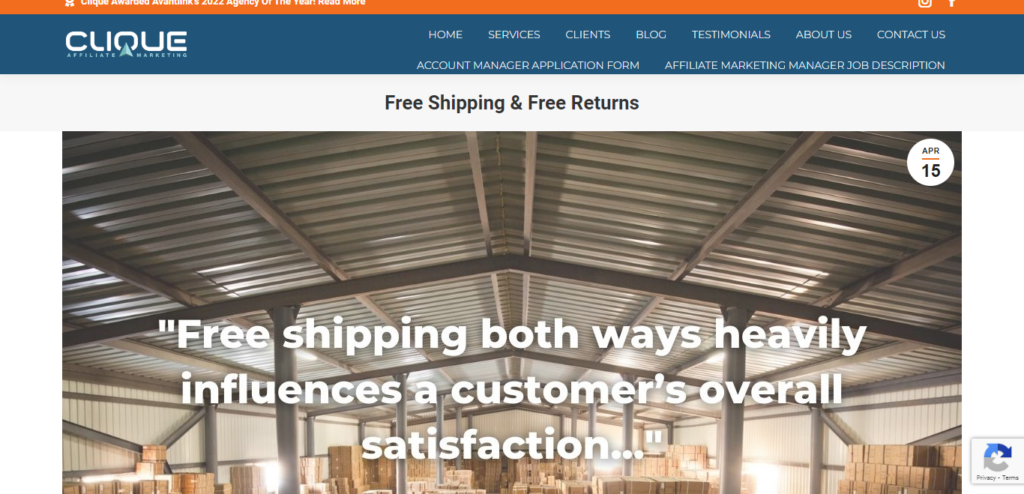
If the customer knows the item will ship free and can return it, they are more likely to buy it.
Ensure your company prioritizes customer service and has representatives available online, over the phone, and in-store to communicate with your customers.
Conclusion
Businesses can increase their revenues by learning how to encourage impulsive shopping behavior.
Although certain personality types are more likely to make an impulse purchase, most consumers are guilty of this as well.
You can do certain things from a marketing perspective to trigger an impulsive response from your customers.
First, focus on the right products.
Then, use marketing campaigns to make customers think they are missing out on a great deal if they don’t buy something.
Strategically place items in your store and on your website to entice a sale.
The buying process needs to be fast and easy.
Make sure you provide shoppers with excellent customer support options.
Follow these tips to increase your revenue.
What types of products are you strategically placing on your website to target impulse buyers?
